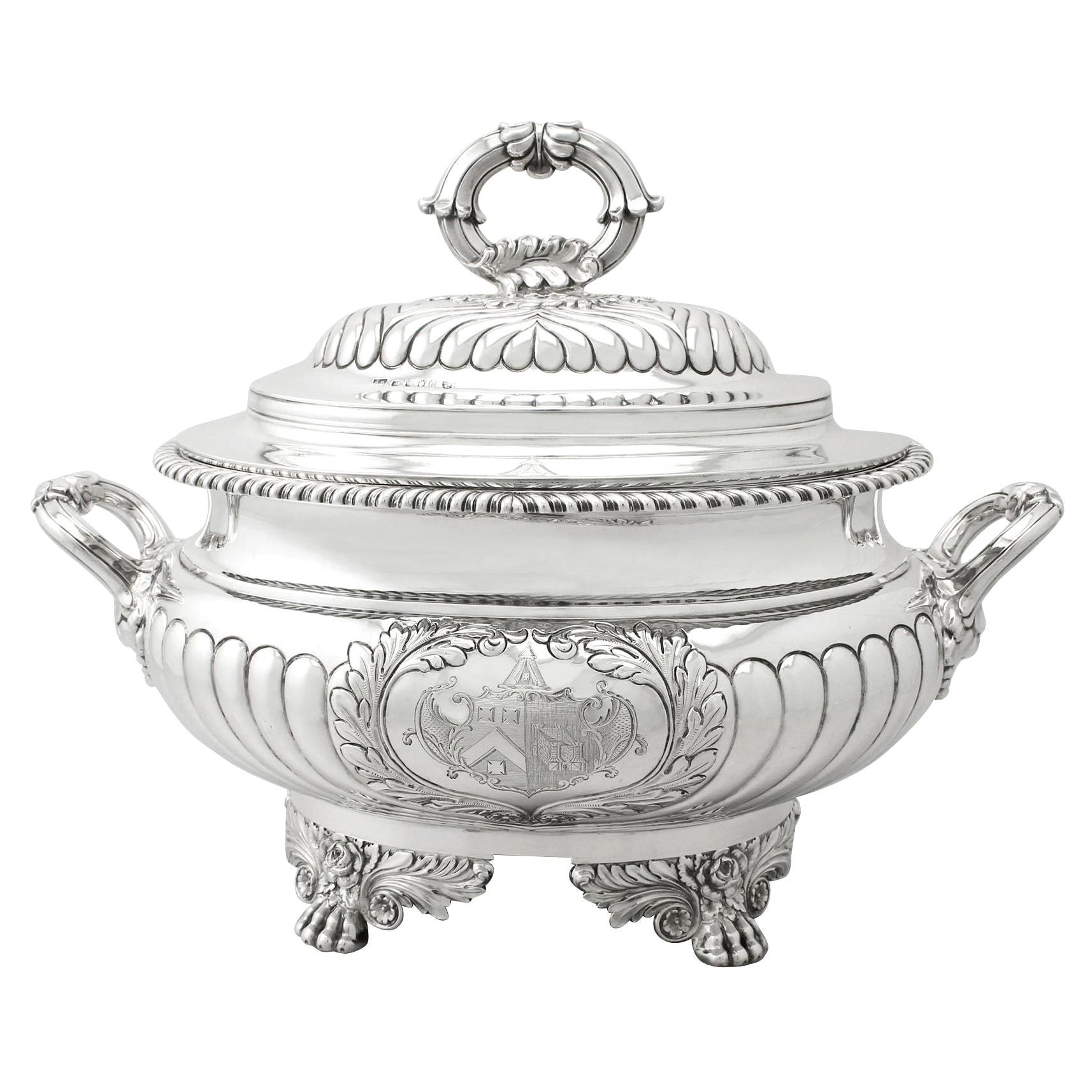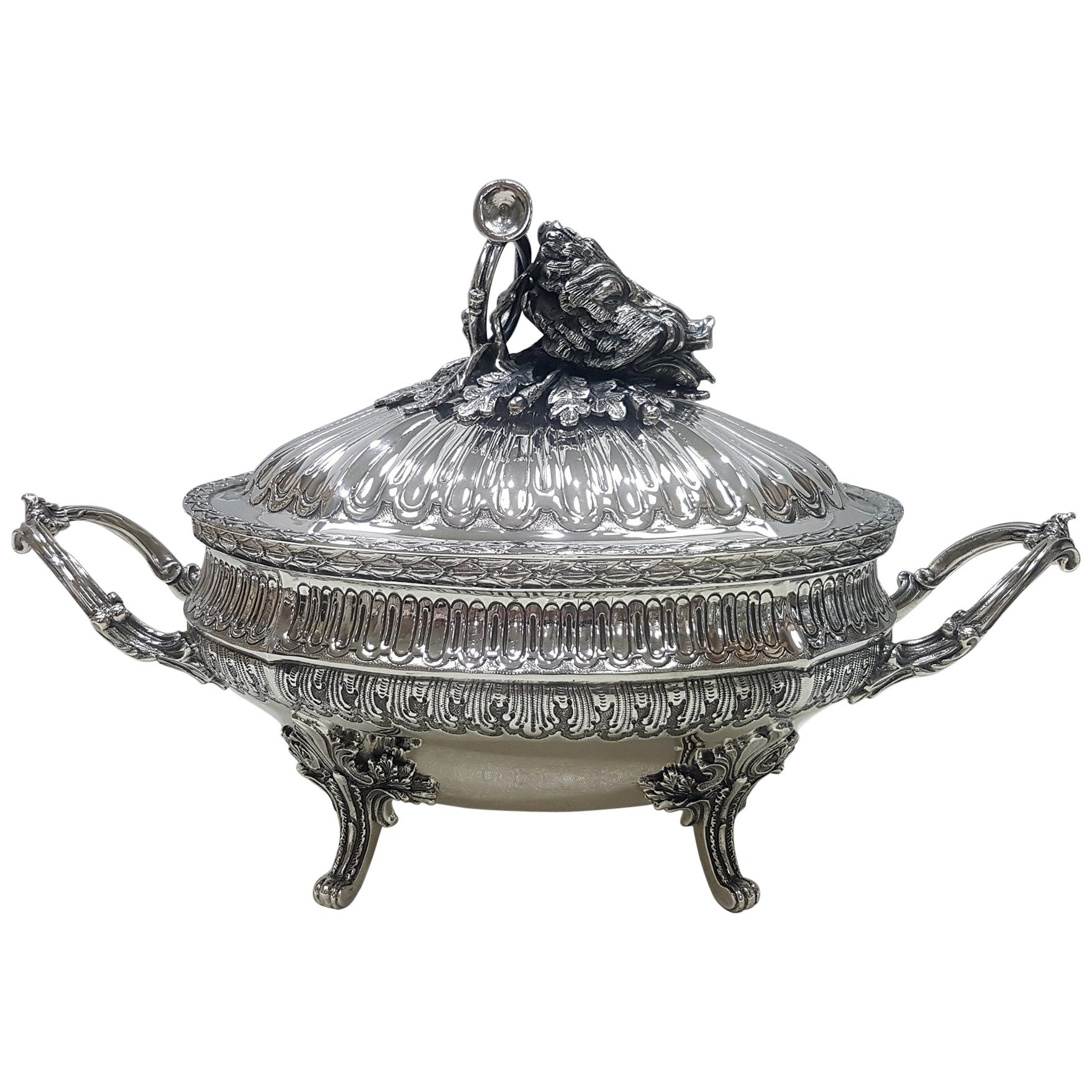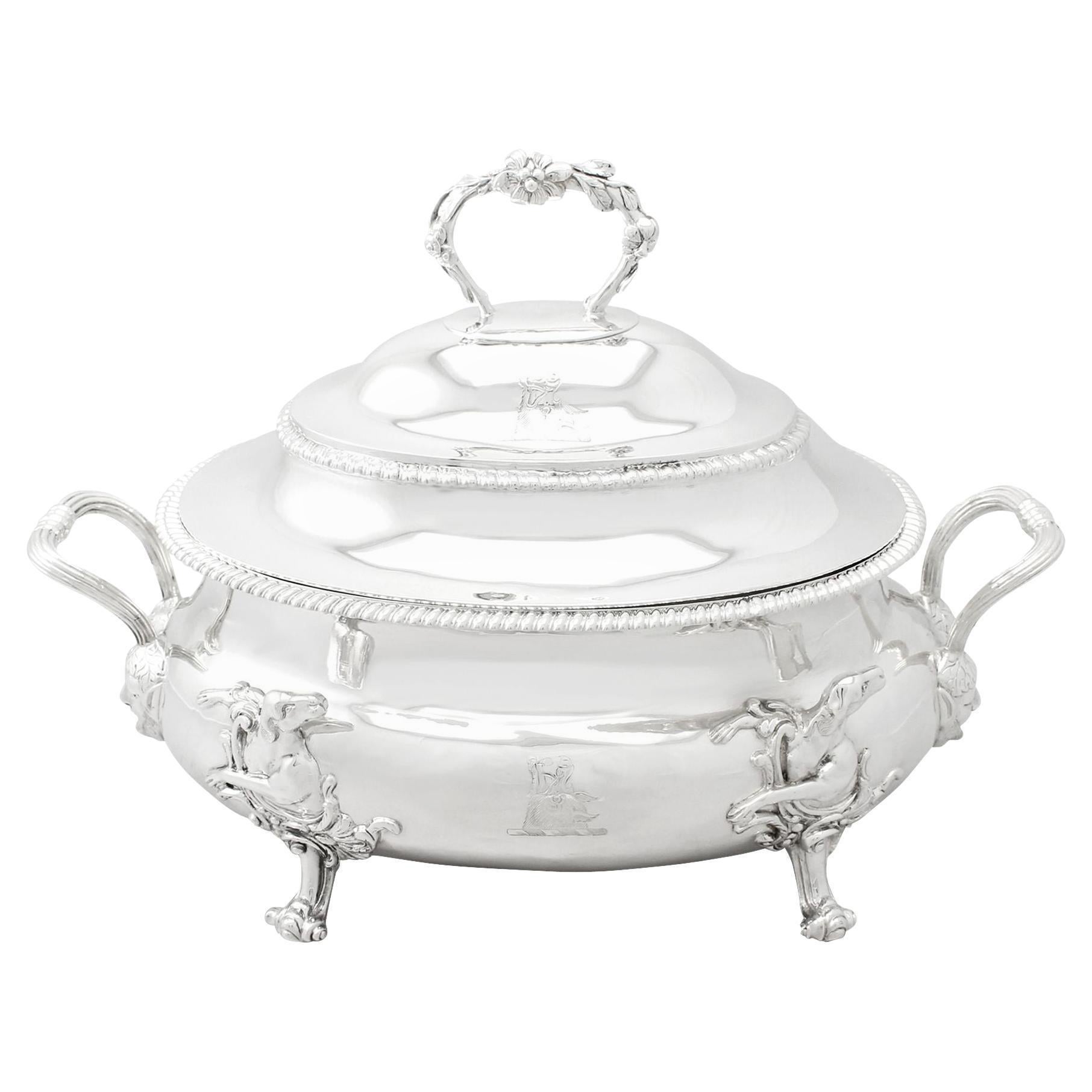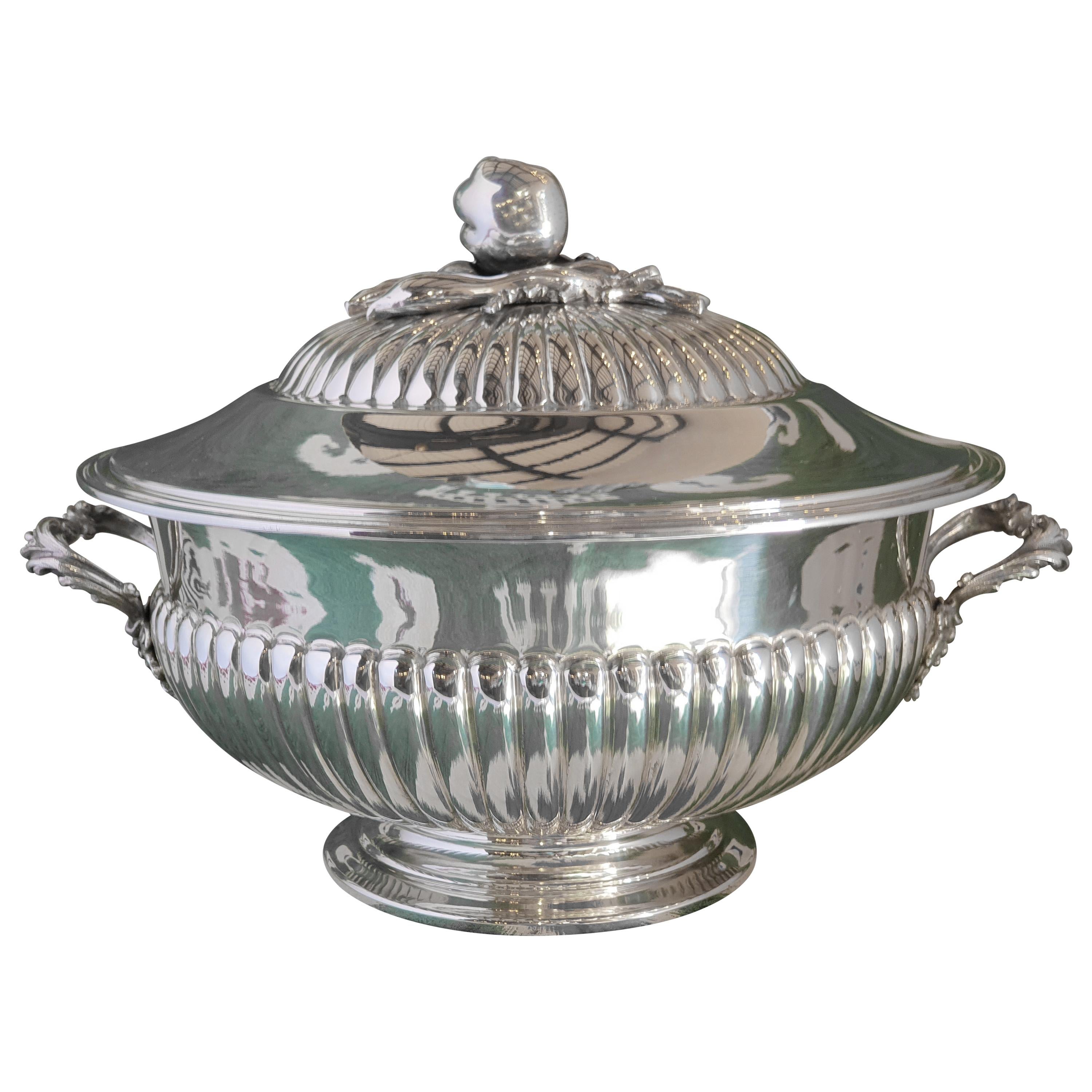Items Similar to Italian Silver Puerperal Cup or Small Soup Tureen, Milan Circa 1830
Video Loading
Want more images or videos?
Request additional images or videos from the seller
1 of 22
Italian Silver Puerperal Cup or Small Soup Tureen, Milan Circa 1830
About the Item
Silversmith L. B.
Small silver soup tureen or puerperal cup with plate and lid
Milan, around 1830
Height 19.5 cm (7.67 in) - diameter 21.7 cm (8.54 in)
lb 2.14 (kg 0.97)
State of conservation: slight use defects and a dent on the plate.
From about the mid-16th century, the puerperal soup tureen or puerperal cup became one of the most popular wedding gifts in central Italy. As an auspicious symbol, it replaced the birth table (“desco da parto”) which, on the occasion of high-ranking marriages, from the 13th century, had been painted by famous artists, especially in Tuscany.
In France this same tureen is called "écuelle de mariée", as it is given to spouses as a sign of fertility.
During the eighteenth century this custom spread even outside Italy to all social levels. Depending on availability and rank, it was made of different materials: precious metals, maiolica, porcelain, glass, pewter, etc.
Beginning in the mid-20th century, the custom of this symbolic homage gradually disappeared, although famous designers such as Gio Ponti and Giuseppe Gariboldi, even as recently as the 1940s, revisited a model of a small puerperal soup bowl for the Ginori and, also in Italy in 1940, in a national competition for young potters, one of the themes of the test was indeed a modern model of a puerperal cup as an auspicious gift.
This small silver tureen has the shape of a hemispherical bowl and rests on a tall cup-shaped foot decorated with parallel lobed and fluted bands. The body is surmounted by a domed lid with a grip in the shape of a playful putto holding a drape. This grip rests upon an elegant decorative motif applied in relief at the top of the lid with palmettes and sinuous florets. On the sides two handles with fitoforme decorations rise from the head of two female masks. The edge with lance-shaped leaves interspersed with small berries is repeated both on the lid and on the edge of the round dish which accompanies the work.
The marks present on the work are the following (the original descriptions are given as they appear on the documents of the Milan State Archive):
1) “Heptagonal form. Globe with the Zodiac and the seven Trioni”. Hallmark of the Guarantee Office in use in the Kingdom of Italy from 1812 for works with a title of 800 thousandths.
2) “Plow”. Hallmark of the Milan Guarantee Office in use since 1812.
3) “A male figure and letters LB”. Silversmith's mark (unidentified).
Bibliography:
G. SAMBONET, Gli argenti milanesi, Longanesi & C., Milano 1987;
V. DONAVER - R. DABBENE, Punzoni degli argentieri milanesi dell’800, ed. San Gottardo, Milano 1988.
- Dimensions:Height: 7.68 in (19.5 cm)Diameter: 8.55 in (21.7 cm)
- Style:Neoclassical (Of the Period)
- Materials and Techniques:Sterling Silver,Embossed
- Place of Origin:
- Period:
- Date of Manufacture:circa 1830
- Condition:Minor fading. Slight use defects and a dent on the plate.
- Seller Location:Milano, IT
- Reference Number:1stDibs: LU4352216512692
About the Seller
4.3
Vetted Seller
These experienced sellers undergo a comprehensive evaluation by our team of in-house experts.
Established in 1860
1stDibs seller since 2018
19 sales on 1stDibs
Typical response time: 4 hours
Associations
International Confederation of Art and Antique Dealers' Associations
- ShippingRetrieving quote...Ships From: Milano, Italy
- Return PolicyA return for this item may be initiated within 14 days of delivery.
More From This SellerView All
- Ancient Italian Maiolica Tureen, Rubati Manufacture, Milan, circa 1770-1780By Pasquale RubatiLocated in Milano, ITMaiolica tureen Pasquale Rubati Manufacture Milan, circa 1770 - 1780 Maiolica polychrome decorated “a piccolo fuoco” (third fire). It measures 6.69 in x 11,02 x 8.26 (17 x 28 x ...Category
Antique 1770s Italian Rococo Ceramics
MaterialsMaiolica
- Large Italian Neoclassic Sterling Silver Coffee Pot, Milan, Circa 1830Located in Milano, ITEmbossed and engraved silver coffee pot Antonio Garavaglia Milan, Circa 1830 It measures 16.92 in (43 cm) in height and weighs 3.35 lb (1.520 gr) State of conservation: very good The large silver coffee pot has a round mouthpiece with a marked everted rim on which a pagoda lid rests; this is surmounted by a cock-shaped knob with a border decorated with small pods...Category
Antique 1820s Italian Neoclassical Sterling Silver
MaterialsSterling Silver
- Ancient Italian Maiolica Tureen Milano, 1770 circaBy Felice Clerici, Pasquale RubatiLocated in Milano, ITMaiolica tureen “allo struzzo” (ostrich decoration) Milan, Felice Clerici or Pasquale Rubati factory, circa 1750-1780 Measures: 9.25 in x 12.79 in x 10.23 in (cm 23.5 x cm 32.5 x cm 26) lb 4.78 (kg 2.17) State of conservation, a felûre consolidated inside with slight edge chipping restored. In Milan in the 18th century two Majolica warehouses were opened, the first, by Felice Clerici, in 1745, the second in 1756 by Pasquale Rubati. Traditionally this type of decoration has been attributed to the Pasquale Rubati factory. In reality the motif “allo struzzo”, one of the clearest examples of how the taste for chinoiserie met with considerable success during the 18th century, had been produced, in specimens of greater or lesser quality, by both Milanese manufactories. This Maiolica tureen has a swollen and ribbed oval bowl, rests on an extroflexed foot and shows stirrup handles. The tri-color ornament, in the typical tones of Japanese "Imari" decorations, shows an idealized oriental landscape that develops around a perforated rock and has a willow tree with long lance-shaped leaves framing the long-legged bird figure. The ornamentation is enhanced by decorative elements such as butterflies, small florets and a vase with a thin flowery stem. The lid is ribbed with a pear-shaped knob on top. The decoration was called in the Milanese manufactories "allo struzzo" (ostrich decoration) and this refers to the oriental figure Xian He or the crane, symbol of longevity, here losing its symbolic value. It is hypothesized that among some 16th century engravings...Category
Antique 1770s Italian Chinoiserie Ceramics
MaterialsMaiolica
- 19th Century Italian Sterling Silver Madonna, circa 1830Located in Milano, ITEmbossed and engraved silver plaque La Madonna del lago (The Madonna of the Lake) Probably Milan, post 1824 Brass frame It measures 16.14 in x 13.85 in (41 x 35.2 cm) and it weighs 10.357 pounds (4.698 g): silver 1.31 pounds (598 g) + brass 9.03 pounds (4.100 g) State of conservation: some abrasions on the bottom. The frame is old, but not original. The plaque is made up of a sheet of embossed and engraved silver, and held in a solid brass frame. It depicts the “Madonna del lago” – “Madonna of the Lake” - (the Madonna with Child and San Giovannino) by Marco d'Oggiono (Oggiono, 1474 circa - Milan, 1524 circa), while changing only the background landscape. Almost certainly the subject reproduced in the plaque was taken from a famous engraving by Giuseppe Longhi (Monza, 1766 - Milan, 1831), one of the greatest engravers of his era. The silver is unmarked, probably because originally the Madonna was due to be exposed in a church: sometimes precious metals destined for worship and liturgical use would be exempted from payment and were, therefore, not marked. It is very likely that the plaque was made in Milan because in this city in 1824 the engraving by Giuseppe Longhi was made and printed. In addition, in Milan, the alleged lost painting by Leonardo da Vinci in his Milanese period (1482-1500) would be produced; this is the painting from which Marco d'Oggiono took his version. The painting Marco d?Oggiono was one of Leonardo da Vinci's most brilliant students and collaborators (D. Sedini, Marco d’Oggiono, tradizione e rinnovamento in Lombardia tra Quattrocento e Cinquecento, Roma 1989, pp. 151-153, n. 56; p. 225, n. 124, with previous bibliography). His style reflects in every way that of the Tuscan Maestro, so much so that he was the one who executed some copies of da Vinci's paintings. The execution of the “Madonna del Lago” probably draws inspiration from a lost painting by the Maestro, created while he was living in Milan (1482-1500). There are many similarities with other works by Leonardo such as the “Vergine delle rocce” or the “Vergine con il Bambino e San Giovannino, Sant’Anna e l’Agnello”. The painting, from which the drawing and then the famous engraving were taken, is found today at the M&G Museum of Bob Jones University in Greenville, South Carolina, where it came to rest after the sale of the Harrington Collection in London in 1917. The work appears in the inventories of the collection of Napoleon and Joséphine Bonaparte at the castle of Malmaison, before 1809. The Malmaison building was born and developed in the 17th and 18th centuries. In the 18th century it belonged to Jacques-Jean Le Coulteux du Molay, a wealthy banker. Later, during the Directory, Joséphine Bonaparte de Beauharnais bought it on April 21st, 1799, but settled at the castle definitively only after her husband separated from her in 1809. She remained there until 1814, the year of her death. When Joséphine died, the estate passed to her son Eugène de Beauharnais, who moved to Munich with his whole family in 1815, bringing with him the collection of paintings he inherited from his mother. Eugène died in 1824 and his wife Augusta of Bavaria (von Bayern), unable to keep it, in 1828 sold the Malmaison to the Swedish banker Jonas-Philip Hagerman. It is likely that in this period Augusta also sold part of the paintings inherited from her husband, including the “Madonna del Lago”. This painting then came into the possession of Leicester Stanhope, fifth Earl of Harrington (1784 - 1862) and then was passed down to his descendants. In 1917, at the death of Charles, eighth Earl of Harrington, his brother Dudley inherited the title and properties and he put up a part of his collections for sale. Among these, precisely, the painting by Marco d'Oggiono was to be found. On the occasion of that auction the painting was presented as a work by Cesare da Sesto, by virtue of a handwritten note by the Countess of Harrington on the back of the table. However, already in 1857, the German critic Gustav Waagen had identified Marco d'Oggiono as the author of the painting, then exhibited in the dining room of Harrington House in London (Treasures of Art in Great Britain, in 4 volumes, London, 1854 and 1857). The engraving Giuseppe Longhi was one of the most renowned engravers in Italy between the end of the 18th century and the first quarter of the 19th century. In 1824 Giuseppe Longhi, based on a design by Paolo Caronni, made a famous engraving of the painting of Marco d?Oggiono. The activity of Longhi was then at the peak of his notoriety, enough to earn him very substantial commissions; it is not risky to suppose that some of his successful engravings were also reproduced using other means: in our case in silver. (A. Crespi, a cura di, Giuseppe Longhi 1766–1831 e Raffaello Morghen...Category
Antique 1820s Italian Neoclassical Sterling Silver
MaterialsSterling Silver, Brass
- Pair of Italian Maiolica Tureens, Ferretti Manufacture, Lodi Circa 1770 - 1780By Antonio FerrettiLocated in Milano, ITPair of maiolica tureens Antonio Ferretti Manufacture Lodi, circa 1770-1780 Maiolica polychrome decorated “a piccolo fuoco” (third fire). a – 8.66 x 11.02 x 7.48 in (22 x 28 x 19...Category
Antique 1770s Italian Rococo Ceramics
MaterialsMaiolica
- Ancient Italian Neoclassic Sterling Silver Coffee Pot, Milan, circa 1850Located in Milano, ITEmbossed and engraved sterling silver coffee pot Tommaso Panizza (1805-1868) Milan, circa half of the 19th century It measures 13.97 in (cm 35.5) in height x 8.66 in (22 cm) x 4.7...Category
Antique 1840s Italian Neoclassical Sterling Silver
MaterialsSterling Silver
You May Also Like
- Antique Sterling Silver Soup Tureen or CenterpieceBy James Barber & William WhitwellLocated in Jesmond, Newcastle Upon TyneA magnificent, fine and impressive, rare antique George IV English sterling silver soup tureen assayed in York; an addition to our dining silverware collection. This magnificent antique George IV English sterling silver soup tureen has an oval rounded form. The lower portion of the body is encompassed with impressive chased fluted decoration in a subtle swirl design. The decoration to the body incorporates an impressive scrolling leaf bordered cartouche to either side, each displaying an exceptional contemporary bright cut engraved marital coat of arms* depicting on the dexter a chevron between three crosses paty and the sinister a quadrangular castle. The coat of arms is surmounted with a bright cut engraved crest displaying a tent adorned or lined charged in the interior with a cross paty of the third. The plain waisted upper portion is encompassed with a Fine and impressive applied gadroon decorated border to the flared rim. This antique soup tureen...Category
Antique 1820s English George IV Sterling Silver
MaterialsSilver, Sterling Silver
- 20th Century Italian Silver Soup Tureen Empire Style by Vittorio Manzoni, MilanLocated in VALENZA, ITGorgeous solid silver tureen in Empire style on feet with handles. The body of the tureen is completely hammered by hand, embossed and chiseled with the typical designs of the Empire...Category
Vintage 1960s Italian Empire Sterling Silver
MaterialsSilver
- American Silver Covered Soup Tureen, circa 1875Located in New York, NYWith medallions of classical figures and reindeer handles. Marked: 900/1000, Maker: Wood and Hughes, New York.Category
Antique 1870s American Soup Tureens
MaterialsSilver
- Antique Victorian Silver Soup TureenLocated in London, GBAn antique Victorian silver soup tureen and cover of shaped oval form and having a reeded border. The height to the top of the urn-shaped fin...Category
Antique 19th Century British Soup Tureens
MaterialsSilver
- Antique Georgian English Sterling Silver Soup TureenLocated in Jesmond, Newcastle Upon TyneAn exceptional, fine and impressive antique Georgian English sterling silver soup tureen; an addition to our dining silverware collection. This exceptional antique George III English sterling silver soup tureen has an oval rounded form. The plain surface of the body is embellished with a contemporary bright cut engraved crest depicting a boar's head erect and couped. The upper flared rim of the tureen is encompassed with a fine and impressive applied gadroon decorated border. This antique soup tureen...Category
Antique Early 1800s English George III Sterling Silver
MaterialsSilver, Sterling Silver
- 21st Century Sterling Silver Soup Tureen, Italy, 2001By Argenteria AugeLocated in Cagliari, ITA stunning handcrafted sterling silver soup tureen. Beautiful work of ribbed chisel on the lower part and on the lid, the knob represents a tomato and legumes in an extremely realist...Category
Early 2000s Italian Rococo Revival Soup Tureens
MaterialsSterling Silver
Recently Viewed
View AllMore Ways To Browse
Silver Stater
Antique Silver Side Table
Sterling Small Plates
Small Sterling Silver Plates
Italian 800 Silver
800 Italy Silver
Parallel Silver
Milan Plate
Figural Silver Handle
Antique Sterling Silver Cup
Antique Sterling Silver Cups
Silver Metal Side Table
Silver Table Round Modern
Antique Wedding Gift
Footed Silver Cup
Silver Two Handled Bowl
Round Mid Century Dining Table With Leaves
Antique Embossed Sign





